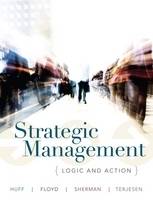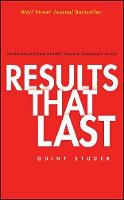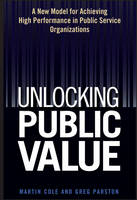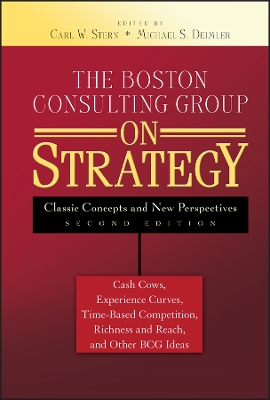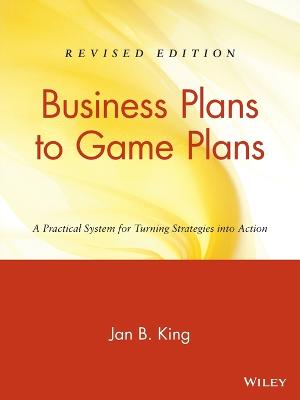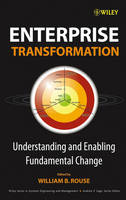Strategic Management
Strategic Management
Logic and Action
; ; ;
John Wiley & Sons Inc
08/2008
448
Mole
Inglês
9780471017936
616
Descrição não disponível.
1. Define Strategy. What Are the Characteristics of Effective Strategy? How Are Strategies Influenced By Other Strategists? How Do They Lead Others? Why Are the Successes and Failures of Other Organizations Important? Conclusions for the Strategist. Key Concepts. Questions for Further Reflection. Notes. 2. Developing Resources. Which Firm Resources are Associated with Competitive Advantage? How Are Competitive Resources Created and Sustained? What Risks Are Associated with Resource Accumulation? How is Resource Accumulation and Deployment Strategically Managed? Conclusions for the Strategist. Key Concepts. Questions for Further Reflection. Notes. 3. Serving Customers. Why is the Customer Relationship Increasingly Critical? What is a Service Mentality? What Are the Guidelines for a Customer-Based Business Model? How Do Companies Gather Data to Identify and Understand Their Customers? Can the Customer Connection Be Overemphasized? Conclusions for the Strategist. Key Concepts. Questions for Further Reflection. Notes. 4. Seeking Opportunity. What Signals the Capacity to Develop Opportunity? What Are the Processes of Opportunity Development? What Are the Differences between Small Firm and Corporate Entrepreneurship? Is Ambidexterity the Answer? Conclusions for the Strategist. Key Concepts. Questions for Further Reflection. Notes. 5. Competing with Rivals. What Distinguishes Competitive Environments? What Affects Profit Potential in Different Environments? How Do Macro Forces Affect the Evolution of Competitive Conditions? How Do Asymmetries Help Explain Competitive Advantage? What Are Generic Strategies for Achieving Competitive Advantage? What Are the Characteristics of Hypercompetition? When Do Competitors Collaborate? Conclusions for the Strategist. Key Concepts. Questions for Further Reflection. Notes. 6. Specifying a Business Model. What Are Common Business Models? How Can Value Chain Analysis Contribute to Strategic Change? How Can the Life Cycle Be Used as a Source of Business Model Ideas? What Can Be Learned from Competitors, Customers, and Others? How Do Business Plans Differ from Business Models? Conclusions for the Strategist. Key Terms. Questions for Further Reflection. Notes. 7. Considering Corporate Strategy. How Do Strategies Pursue Growth? How Are Economic Transactions among Firms Facilitated? Can Diversification Leverage Core Competence? When Is Learning an Outcome of Alliance? Conclusions for the Strategist. Key Concepts. Questions for Further Reflection. Notes. 8. Thinking Globally. What Are the Advantages and Disadvantages of International Diversification? How Can Competitive Advantage Be Increased through International Expansion? What Are Alternative Strategies for International Expansion? What Are Alternative Entry Modes? What Are Significant Cross-Cultural Differences? Conclusions for the Strategist. Key Concepts. Questions for Further Reflection. Notes. 9. Acting Responsibly. What is Sustainable Strategy? How Are Standards for Corporate Governance Changing? What Are Internal Forces for Social Responsibility? What Intensifies Ethical Dilemmas? Conclusions for the Strategist. Key Concepts. Questions for Further Reflection. Notes. 10. Ensuring Execution. How Can Strategy Execution Support the Increasing Need for Flexibility? How Is Strategic Planning Changing? How Is Individual and Unit Performance Improved? Conclusions for the Strategist. Key Concepts. Questions for Further Reflection. Notes. 11. Managing Knowledge. Why Is Knowledge an Increasingly Important Source of Sustainable Advantage? What Are the Characteristics of Knowledge Needed by Companies? How Do Strategists Manage and Use Knowledge? How Do Organizational Systems Affect Knowledge Management? What Are the Most Important External Sources of Knowledge? Conclusions for the Strategist. Key Concepts. Questions for Further Reflection. Notes. 12. Providing Leadership. What Are Contemporary Definitions of Leadership? What Are the Most Important Activities of Strategic Leaders? How Are High-Performance Organizations Created and Maintained? Conclusions for the Strategist. Key Concepts. Questions for Further Reflection. Notes. 13. Personal Strategizing. What Are the Trends Shaping Future Work? How Is the Employment Relationship Changing? What Are the Most Important Career-Planning Activities? Why Be Purposeful About Work/Life Balance? Conclusions for the Strategist. Notes. Index.
Este título pertence ao(s) assunto(s) indicados(s). Para ver outros títulos clique no assunto desejado.
strategic management for students; MBA strategic management text; senior-level college management book; strategic thinking for management students; management student worksheets; critical customer relationships; concepts of strategic management; guide for management strategists; organizational success and failure; create competitive resources; learn strategic resource management; customer-based business guidelines; develop competitive resources; effective strategies for management students
1. Define Strategy. What Are the Characteristics of Effective Strategy? How Are Strategies Influenced By Other Strategists? How Do They Lead Others? Why Are the Successes and Failures of Other Organizations Important? Conclusions for the Strategist. Key Concepts. Questions for Further Reflection. Notes. 2. Developing Resources. Which Firm Resources are Associated with Competitive Advantage? How Are Competitive Resources Created and Sustained? What Risks Are Associated with Resource Accumulation? How is Resource Accumulation and Deployment Strategically Managed? Conclusions for the Strategist. Key Concepts. Questions for Further Reflection. Notes. 3. Serving Customers. Why is the Customer Relationship Increasingly Critical? What is a Service Mentality? What Are the Guidelines for a Customer-Based Business Model? How Do Companies Gather Data to Identify and Understand Their Customers? Can the Customer Connection Be Overemphasized? Conclusions for the Strategist. Key Concepts. Questions for Further Reflection. Notes. 4. Seeking Opportunity. What Signals the Capacity to Develop Opportunity? What Are the Processes of Opportunity Development? What Are the Differences between Small Firm and Corporate Entrepreneurship? Is Ambidexterity the Answer? Conclusions for the Strategist. Key Concepts. Questions for Further Reflection. Notes. 5. Competing with Rivals. What Distinguishes Competitive Environments? What Affects Profit Potential in Different Environments? How Do Macro Forces Affect the Evolution of Competitive Conditions? How Do Asymmetries Help Explain Competitive Advantage? What Are Generic Strategies for Achieving Competitive Advantage? What Are the Characteristics of Hypercompetition? When Do Competitors Collaborate? Conclusions for the Strategist. Key Concepts. Questions for Further Reflection. Notes. 6. Specifying a Business Model. What Are Common Business Models? How Can Value Chain Analysis Contribute to Strategic Change? How Can the Life Cycle Be Used as a Source of Business Model Ideas? What Can Be Learned from Competitors, Customers, and Others? How Do Business Plans Differ from Business Models? Conclusions for the Strategist. Key Terms. Questions for Further Reflection. Notes. 7. Considering Corporate Strategy. How Do Strategies Pursue Growth? How Are Economic Transactions among Firms Facilitated? Can Diversification Leverage Core Competence? When Is Learning an Outcome of Alliance? Conclusions for the Strategist. Key Concepts. Questions for Further Reflection. Notes. 8. Thinking Globally. What Are the Advantages and Disadvantages of International Diversification? How Can Competitive Advantage Be Increased through International Expansion? What Are Alternative Strategies for International Expansion? What Are Alternative Entry Modes? What Are Significant Cross-Cultural Differences? Conclusions for the Strategist. Key Concepts. Questions for Further Reflection. Notes. 9. Acting Responsibly. What is Sustainable Strategy? How Are Standards for Corporate Governance Changing? What Are Internal Forces for Social Responsibility? What Intensifies Ethical Dilemmas? Conclusions for the Strategist. Key Concepts. Questions for Further Reflection. Notes. 10. Ensuring Execution. How Can Strategy Execution Support the Increasing Need for Flexibility? How Is Strategic Planning Changing? How Is Individual and Unit Performance Improved? Conclusions for the Strategist. Key Concepts. Questions for Further Reflection. Notes. 11. Managing Knowledge. Why Is Knowledge an Increasingly Important Source of Sustainable Advantage? What Are the Characteristics of Knowledge Needed by Companies? How Do Strategists Manage and Use Knowledge? How Do Organizational Systems Affect Knowledge Management? What Are the Most Important External Sources of Knowledge? Conclusions for the Strategist. Key Concepts. Questions for Further Reflection. Notes. 12. Providing Leadership. What Are Contemporary Definitions of Leadership? What Are the Most Important Activities of Strategic Leaders? How Are High-Performance Organizations Created and Maintained? Conclusions for the Strategist. Key Concepts. Questions for Further Reflection. Notes. 13. Personal Strategizing. What Are the Trends Shaping Future Work? How Is the Employment Relationship Changing? What Are the Most Important Career-Planning Activities? Why Be Purposeful About Work/Life Balance? Conclusions for the Strategist. Notes. Index.
Este título pertence ao(s) assunto(s) indicados(s). Para ver outros títulos clique no assunto desejado.
strategic management for students; MBA strategic management text; senior-level college management book; strategic thinking for management students; management student worksheets; critical customer relationships; concepts of strategic management; guide for management strategists; organizational success and failure; create competitive resources; learn strategic resource management; customer-based business guidelines; develop competitive resources; effective strategies for management students

